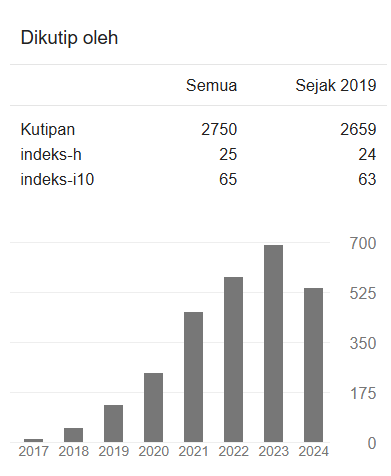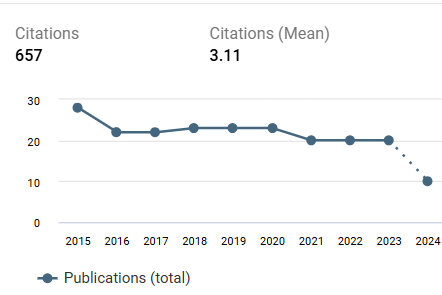Pengembangan aplikasi “CPA” (Covid-19 prevention application) sebagai literasi mitigasi bencana covid-19 bagi siswa SMP
DOI:
https://doi.org/10.22219/jinop.v7i2.16761Keywords:
CPA app, Literacy, Disaster MitigationAbstract
The Covid-19 pandemic has brought major changes, including education where most learning activities are conducted online. It is thus necessary to adapt into online learning policies where innovation is urgently needed. Among the innovations is an e-book titled Covid-19 Prevention Application (CPA) that contains Covid-19 disaster mitigation literacy for students. This research aims to: 1) produce an app for CPA; and 2) test the feasibility level of CPA app as a learning resource. The material in CPA app relates to disaster mitigation, linked to the Social Studies Learning for junior high schools, namely Social Change for the 9th graders (Class IX.1) at SMPN 21 Malang. This research and development modified Borg & Gall model, which is relevant to constructivism learning theory, Edgar Dale’s theory of experience, and cybernetic learning theory. Results show that the development of the CPA app is “highly feasible”. This result implied that CPA app offers solutions to help students in mitigating the Covid-19 disaster through creative learning. It is suggested that further large-scale trials will be conducted in the future to measure the level of effectiveness.
Downloads
References
Arif, M. (2021). Penggunaan video untuk meningkatkan hapalan anak usia dini. Jurnal Motoric Media of Teacing and Children, 5(1), 6.
Aryani, N., Desyanty, E. S., & Listyaningrum, R. A. (2021). Pemanfaatan Teknologi pembelajaran sebagai upaya meningkatkan motivasi belajar dalam pendidikan nonformal dan informal. Prosiding Seminar Nasional Peta Jalan Pendidikan Dan Rancangan Undang-Undang Sistem Pendidikan Nasional, 66–72.
Federasi Serikat Guru Indonesia. (2020). FSGI catat ratusan guru terkena corona, 42 orang di antaranya meninggal _ Federasi Serikat Guru Indonesia.
Firman, F., & Rahayu, S. (2020). Pembelajaran online di tengah pandemi Covid-19. Indonesian Journal of Educational Science (IJES), 2(2), 81–89. https://doi.org/10.31605/ijes.v2i2.659
Gall, M. ., Gall, J. ., & Borg, W. . (2003). Educational research: An introduction (7th ed.). Allyn & Bacon.
Hadi, S. (2017). Efektivitas penggunaan video sebagai media. Prosiding TEP & PDs, Tema: 1 No, 96–102.
Hairi, P. J. (2020). Implikasi hukum pembatasan sosial berskala besar terkait pencegahan Covid-19. Info Singkat Bidang Hukum, 12(April), 1–6.
Herlina, Muhammad Lutfi, A. (2018). Pengembangan aplikasi mobile learning pra nikah berbasis android dengan menggunakan teknologi unity 3D V5. JURNAL INSTEK: Informatika Sains Dan Teknologi, 3(2), 211–220.
Hidayat, A., Suyatna, A., & Suana, W. (2017). Pengembangan buku elektronik interaktif pada materi fisika kuantum kelas XII SMA. Jurnal Pendidikan Fisika, 05(02), 87–101.
Huda, M. (2016). Pembelajaran berbasis multimedia dan pembelajaran konvensional (Studi komparasi di MTs Al-Muttaqin Plemahan Kediri). Jurnal Penelitian, 10(1), 125–146. https://doi.org/10.21043/jupe.v10i1.865
Jannah, N., Fadiawati, N., & Tania, L. (2017). Pengembangan e-book interaktif berbasis fenomena kehidupan sehari-hari tentang pemisahan campuran. Jurnal Pendidikan Dan Pembelajaran Kimia, 6(1), 186–198.
Jannah, U. (2019). Pengembangan ebook interaktif menulis teks eksplanasi berbasis GLS Untuk siswa kelas XI SMAN 1 Tenggarang Bondowoso. Nosi, 7(2), 1–7.
Khoirun. (2017). Kerucut pengalaman Edgar Dale. In Civitas UNS.
Marbun, P. (2020). Disain pembelajaran online pada era dan pasca Covid-19. CSRID Journal, 12(2), 129–142.
Martha, Z. D., Adi, E. P., & Soepriyanto, Y. (2018). E-book berbasis mobile learning. Jurnal Kajian Teknologi Pendidikan, 1(2), 109–114.
Misbah, M., Sahibudin, M., Islam, U., Prof, N., & Saifuddin, K. H. (2021). Dale’s theory dan Bruner’s theory (analisis media dalam pentas wayang santri ki enthus susmono). 8(2), 225–238.
Mohammed, M., Ebied, A., Ahmed, S., & Rahman, A. (2015). The effect of interactive e-book on students’ achievement at najran university in computer in education course. Journal of Education and Practice, 6(19), 71–83.
Mustafa, P. S., & Roesdiyanto, R. (2021). Penerapan teori belajar konstruktivisme melalui model PAKEM dalam permainan bolavoli pada sekolah menengah pertama. Jendela Olahraga, 6(1), 50–56. https://doi.org/10.26877/jo.v6i1.6255
Nabila, P. W., Rudibyani, R. B., & Sofya, E. (2019). Efektivitas media e-book untuk meningkatkan motivasi dan penguasaan konsep siswa. Jurnal Pendidikan Dan Pembelajaran Kimia, 8(3), 469–481.
Nasution, S., & Islam. (2018). Pengembangan model pembelajaran bahasa Arab Arabi : Journal of Arabic Studies. Arabi, 3(2), 121–144.
Nugroho, P. (2016). Pengembangan Model pembelajaran IPS terpadu berbasis lingkungan. Jurnal Ilmu Pendidikan Universitas Negeri Malang, 22(2), 114077.
Nugroho, S. A. (2016). Peningkatan keaktifan dan hasil belajar siswa melalui penerapan teori konstruktivisme berbasis media wondershare quizcreator. Indonesian Journal of Curriculum and Educational Technology Studies, 4(2), 73–78. https://doi.org/10.15294/ijcets.v4i2.14310
Ratnawati, E. (2016). Karakteristik teori-teori belajar dalam proses pendidikan (perkembangan psikologis dan aplikasi). Edueksos: Jurnal Pendidikan Sosial & Ekonomi, 4(2), 1–23.
Rina Tiya Lestari 1 , Eka Pramono Adi 2, Y. S. 3. (2016). Ebook media pembelajaran interaktif. E - ISSN: 2615-8787 E-BOOK, 71–76.
Rodhiah, S. A., & Roza, L. (2020). Hasil analisis kebutuhan pengembangan ebook berbasis multipel representasi. Prosiding Seminar Nasional Pendidikan Fisika FITK UNSIQ, 2(1), 143–149.
Rohani. (2019). Diktat media pembelajaran. 95.
Salim, S., & Maryanti, E. (2017). Pengembangan perangkat pembelajaran matematika melalui teori pembelajaran sibernetik berbantuan software derive. Jurnal Riset Pendidikan Matematika, 4(2), 229. https://doi.org/10.21831/jrpm.v4i2.16068
Sari, P. (2019). Analisis terhadap kerucut pengalaman Edgar Dale dan keragaman gaya belajar untuk memilih media yang tepat dalam pembelajaran. Mudir: Jurnal Manajemen Pendidikan, I(1), 58–78.
Sugrah, N. U. (2020). Implementasi teori belajar konstruktivisme dalam pembelajaran sains. Humanika, 19(2), 121–138. https://doi.org/10.21831/hum.v19i2.29274
Suminar, T. (2016). Tinjauan filsafati (ontologi, epistemologi dan aksiologi manajemen pembelajaran berbasis teori sibernetik. Edukasi, 1(2).
Supardan, D. (2016). Teori dan praktik pendekatan konstruktivisme dalam pembelajaran. Edunomic, 4(1), 1–12.
Suprapti, E. (2018). Penerapan teori belajar konstruktivisme untuk meningkatkan hasil belajar mahasiswa pada mata kuliah matematika dasar. MAJAMATH: Jurnal Matematika Dan Pendidikan Matematika, 1(1), 24. https://doi.org/10.36815/majamath.v1i1.116
Syamsidar, Maruf, U. M. M., & Hustim, R. (2018). Pembelajaran fisika berbasis cone of experience Edgar Dale. Jurnal Pendidikan Fisika, 6, 1–12.
WHO Indonesia. (2020). WHO Indonesia | World Health Organization.
Wijayanti, M. (2018). Pengembangan e-book IPA fisika berbasis program sigil peserta didik SMPN 23 Simbang Kabupaten Maros. Seminar Nasional Fisika 2018, 1–5.
Yunus, R. (2018). Teori belajar sibernetik dan implementasinya dalam pelaksanaan diklat. Journal of Education Science, 4(2), 32–41.
Zaman, B. (2020). Penerapan active learning dalam pembelajaran PAI. Jurnal As-Salam, 4(1), 13–27. https://doi.org/10.37249/as-salam.v4i1.148
Downloads
Published
How to Cite
Issue
Section
License
Copyright (c) 2021 Nabila et al

This work is licensed under a Creative Commons Attribution 4.0 International License.
Copyright Notice
Authors who publish with JINoP (Jurnal Inoasi Pembelajaran) agree to the following terms:
- For all articles published in the JINoP (Jurnal Inovasi Pembelajaran), copyright is retained by the authors. Authors give permission to the publisher to announce the work with conditions. When the manuscript is accepted for publication, the authors agree to the automatic transfer of the publishing right to the publisher.
- Authors retain copyright and grant the journal the right of first publication with the work simultaneously licensed under a Creative Commons Attribution 4.0 International License. that allows others to share the work with an acknowledgment of the work's authorship and initial publication in this journal.
- Authors are able to enter into separate, additional contractual arrangements for the non-exclusive distribution of the journal's published version of the work (e.g., post it to an institutional repository or publish it in a book), with an acknowledgment of its initial publication in this journal.
- Authors are permitted and encouraged to post their work online (e.g., in institutional repositories or on their website) prior to and during the submission process, as it can lead to productive exchanges, as well as earlier and greater citation of published work (See The Effect of Open Access).








